My Favorite 3M Microfilm Machine
3M Model 115 Electron Beam Recorder (EBR) Overview
Last Revised: October 19, 2023
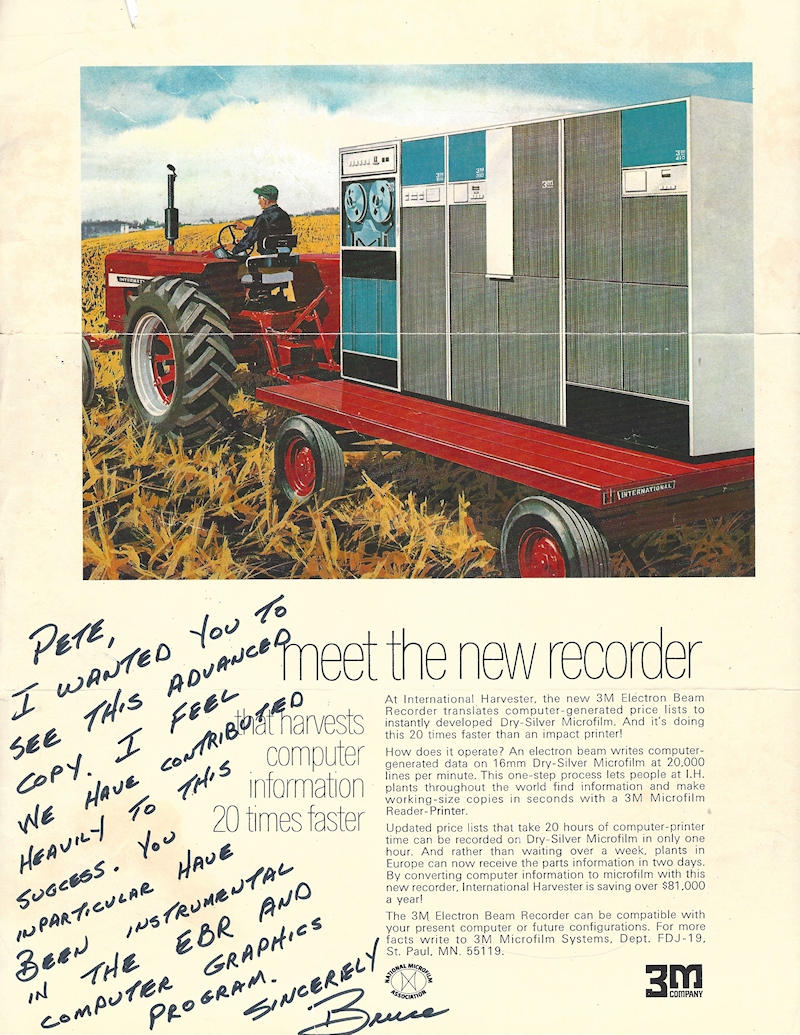
This is the best picture I have so far found of what the "115 EBR" actually looked like.
This advertising piece marks the first of the two original EBR installations in
the world, during the spring and summer of 1968.
This one went to International Harvester's Broadview, Il. Corporate Computer Center. The second one was installed at the computer center of
the University of Minnesota in St. Paul.
If I remember correctly, Harvester was still using IBM 7080's to feed the EBR, while the U of M was running Control Data 6000's.
Within several months of the Harvester installation, that company opened its brand new Corporate Computer Center in Hinsdale, Il,
shifting to IBM 360's, and, of course,moving their EBR to that location.
The EBR consisted of 4 separate units.
-The "110" 10 inch reel-to-reel Tape Reader
-The "210" Controller
-The "310 Series F" Electron Beam Recorder itself
-The "410" Film Processor
The following drawings were made before the final system layout had been firmed up.
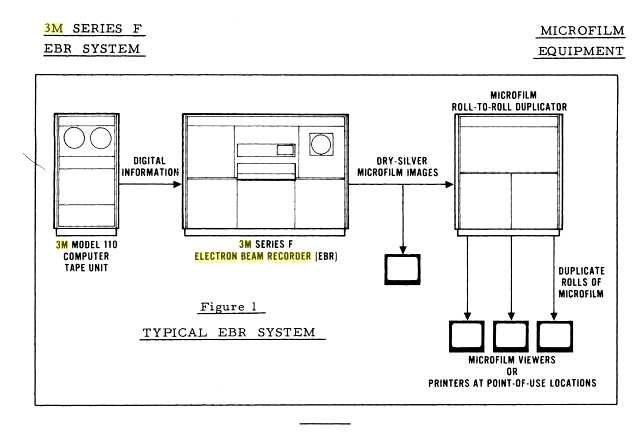
General, but inaccurate, drawing of the 115 EBR as a major component of a Microfilm system for the capture and dissemination of
computer-generated, human readable information
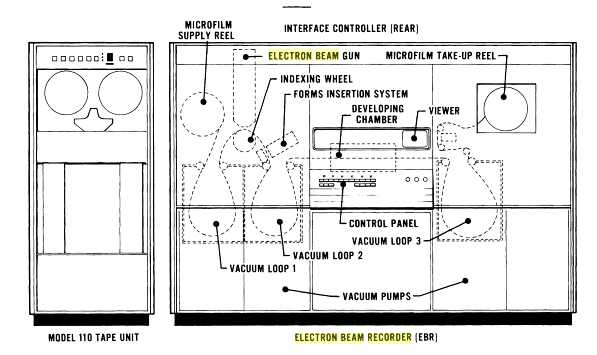
The "110" and "310" EBR portions of the system , still not even close to accurate
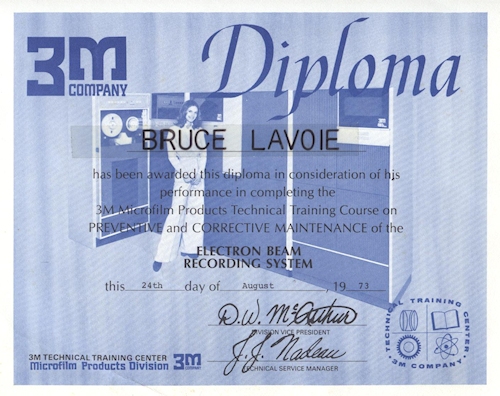
This Tech School Duploma shows a pretty accurate picture of the EBR system, but I don't remember ever having the tape drive turned 90 degrees like that.
And what about the flared pant legs on the model? I quess that dates it!!!
Back to Filmsort-Microfilm Days
French Creek Valley Home
Blacksmithing
Contact Us
Chapter 1, General Information:
The first 3MEBR was put into commercial operation in early 1968 at the data center of the International Harvester Corporation in Broadview Illinois, a
Chicago suburb. The second unit was installed at the computer center of the Universtiy of Minnesota shortly thereafter. It was one of the earliest
(but not the first) "COM" machines of the time; "COM" is an acronym for "Computer Output (to) Microfilm".
One of the problems of the day with computers was the large volumes of (heavy)paper printouts that most users had to contend with. A 3" diameter 100 foot
roll of 16mm microfilm could hold all the data from a 6 Inch high stack of 11" X 14" printer paper, so it was clear that putting all that data directly onto
microfilm would "save the day".
It was the task of the COM machine to convert the computer's digital output data rapidly to microfilm instead of printing it slowly onto paper.
These COM machines accepted a half inch wide magnetic tape, on reels of up to 10" diameter, as their input and outputted microscopically
small images of individual pages of information onto rolls of microfilm. We, at 3M, already had microfilm readers and printers available
for viewing the results and for making paper copies if necessary, but we didn't have a COM machine of our own.
Until that time, all COM machines used basically fine grained black and white "silver gelatin" film. The controller inside the machine
"read" the tapes, turning the codes into characters which were then displayed on a TV-like screen. A film carriage system held the film
in place to be exposed by the "picture" , then advanced the film one frame, while the electronics displayed a new image, and so on. Once a roll of film had
been exposed to the TV-like pages, it was removed from the machine, taken to a processing lab and processed. Only then could the operators
be certain that they had made a quality product.
What was unique about the 3MEBR was that the film it used was a brand new 3M invention called "Dry Silver Film". This film was
processed right in the machine only a few seconds after it was exposed. The machine operator could actually see the end result
in an inspection viewer to determine quality.
This Dry silver film, however, required a lot more exposure energy than did silver gelatin films, so it had to use a very different
exposure system. Scientists at 3M developed a sort of electron microscope that shot electrons directly at the film to expose it.
This meant that the film had to be shuttled into an area of very high vacuum, accurately positioned, exposed, indexed, etc., all while
almost totally excluding any air molecules from invading the electron beam's path. The system could do this at a rate of about 5 and
one half pages per second. Each "page" contained up to 8448 characters, the equivalent of a "computer printout" page of 64 lines with 132
characters per line.
To accomplish all this, the 3MEBR was a pretty big machine. It had:
-the 110 Tape drive; 6 feet tall by about 2 feet wide
-the 210 Data controller; about 5 feet tall and about 2 feet wide
-the 310 Electron Beam Recorder; about 5 feet tall and about 5 feet wide
-the 410 Image Processor; about 5 feet tall and about 2 1/2 feet wide
It had a pretty impressive stance on the computer room floor. It weighed in at about a ton. The electron beam generation and control equipment
required 3 separate high vacuum pumps, 2 oil vapor diffusion pumps and 20 or 30 pilot and vacuum control valves. This was a 3 phase 5 wire 240
volt machine that consumed about 5.5 Kilowatts of electricity. And the system had to be turned on and "pumped down" 24 hours a day, whether
it was being operated or not. To take care of the film handling, it had 5 vacuum cleaner-like motors which had to be running whenever the
system was in use. It was a pretty noisy place to be!
All that said, the machine was very popular for about 15 years, until microfiche outdistanced roll film.
Chapter 2, Component Modules:
The 3MEBR was by far the most complex machine that 3M and the Microfilm Products Division had ever designed and sold to date.
It had just about every kind of mechanical, electrical and electronic component known to man hiding somewhere inside.
3M designed and built the 310 Recorder and the 410 Processor, but farmed out the 210 Controller to CDC's Data Display Division.
The EBR used off the shelf tape drives;
For 800 BPI and lower:
The 110 (seven track), 111 (9 track) and 112 (7/9 track) from Hewlett Packard,
For 1600 BPI:
the 113 from Ampex, and the 114 from Hewlett Packard.
Chapter 3, Production:
Three "Lots" of EBR's were produced over several years.
Lot 1 consisted of 20 units and Lot 2 also had a 20 unit build, if I remember correctly. The 310 Electron Beam Recording unit and the 410 Processor were
were built locally, in I think, Bldg 424, over on Case St. in St. Paul, Mn. This manufacturing floor was usually used to prototype first small lots of
machines.
The tape drives and controllers were brought together with the rest of the machine at this same location, cabled up and fired up there, too. I remember that
one the Methods Engineering guys telling me that, if it took longer than 2 weeks to get a system running and qualified, that the unit would probably be
"on the floor" for about 6 weeks!
Production for Lot 3, the last lot to be built, was moved to 3M's Mincom plant in Camarillo, California. I think there were 50 machines in this lot. Anyone
reading this who sees a correction needed in these numbers should contact me!!!
Chapter 4, Some Technical Details:
The basis for the EBR's electron beam system had been developed several years earlier by 3M Mincom for exposing TV frame scans to silver gelatin film.
I'm still not sure how much of a commercial success that product ever was.
But the Microfilm Products Division took that basic design and built on it to produce the EBR. IIRC, the Mincom device was TV style Horizontal and Vertical
sweeping
device, but the EBR needed exact move-stop-move-stop character positioning and used a device similar to the deflection yoke an a CRT. Then, within a single
character's location, a separate (electrostatic) character stroke-based writing system actually "drew" each 90 micron wide by 120 micron high character.
I think it took 8 1/2 microseconds to write one complete character.
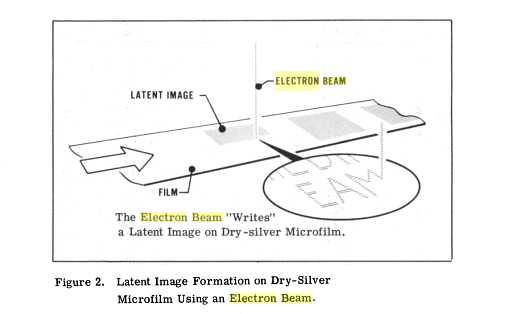
Diagram showing how the 20,750 volt, 1 microamp, 7 micron wide electron beam exposes the dry silver film
So the 115 EBR "modification" from the earlier Mincom design was of major, major proportions.




